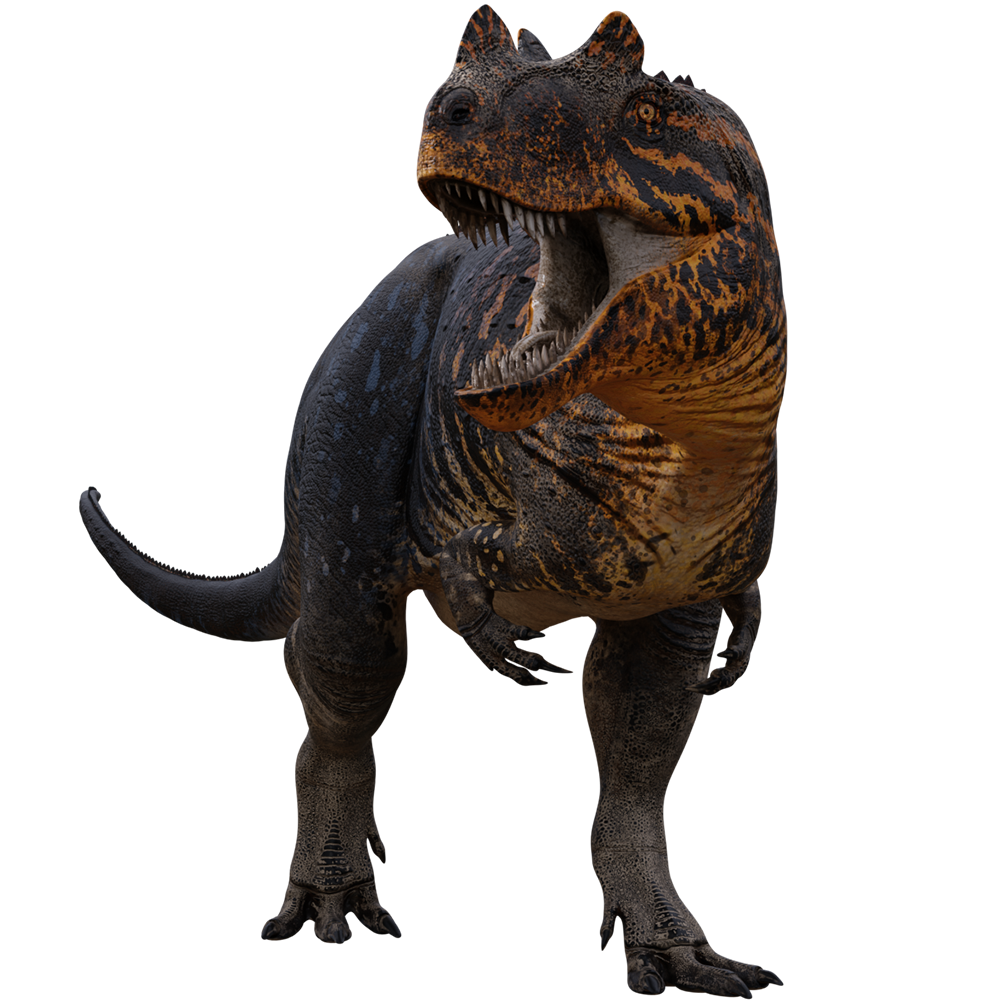The Horned Slasher of the Late Jurassic Forests
Ceratosaurus was specially adapted to survive in a world of fierce competition from other large predators, and sported the proportionally longest slashing teeth of any dinosaur, as well as being the only theropod known to have had a nose horn!
Overview: Discovered in Colorado in the late 19th Century and named by O.C. Marsh of Bone Wars fame, Ceratosaurus is one of the most charismatic dinosaurs of the Late Jurassic Morrison Formation. Its oversized skull with horns over the eyes and nose, and its large jaws lined with extremely long blade-like teeth made this creature stand out both visually and ecologically from other theropods of its environment. While it certainly overlapped and at least occasionally competed with other predators, like the larger Allosaurus and Torvosaurus, it may have used its unique adaptations to avoid much of this competition and eke out a niche where it was an apex predator in its own right.
Discovery: The original specimen (holotype) of Ceratosaurus nasicornis (USNM 4735) was discovered by Marshall Parker Felch in 1883 in the Morrison rocks of Garden Park, near Cañon City, Colorado. It was excavated between 1883-1884. This locality, called Felch Quarry 1, had already produced dinosaur bones, and in addition to Ceratosaurus, also produced a nearly complete Allosaurus during the same years of excavation. It was sent to Othniel Charles Marsh in 1884, who described and named it in the same year. He called the genus Ceratosaurus, meaning “Horn Lizard” from Greek keratos, meaning "horn" and sauros, meaning "lizard". The species name means “nose horn” in Latin, nasus, meaning "nose" and cornu, meaning "horn". So the full meaning of its name is “Nose-horned Horn Lizard”. Another specimen named Ceratosaurus dentisiculatus (UMNH VP 5278) was found in the famous Cleveland-Lloyd Quarry in eastern Utah in the 1960s, and a third specimen, named Ceratosaurus magnicornis, was found near Fruita, Colorado in 1976. However, these specimens are probably not separate species, but just different growth stages of C. nasicornis, and the holotype was probably a subadult. A juvenile Ceratosaurus was discovered in Bone Cabin Quarry in Wyoming in 1999. The current largest specimen was found in the Agate Basin Quarry near Moore, UT, found in 1992. In addition to these five main specimens, fragmentary material has been uncovered in other Morrison sites, including a few bones from Brigham Young University’s famous Dry Mesa Quarry in western Colorado, an isolated premaxilla from Dinosaur National Monument in Utah near the Colorado border, and isolated teeth from Colorado’s Mygatt Moore Quarry. Despite only being known from a handful of specimens, most of them are reasonably complete, including complete skulls, allowing for a good understanding of this animal.
Evolution: Ceratosaurus was a theropod belonging to the clade Ceratosauria, which split off from other theropods at the beginning of the Jurassic. Ceratosaurs tended to have notable skull ornamentation, and unlike tetanuran theropods (Megalosauroids, Allosauroids, and Coelurosaurs) which had three or fewer fingers on the hand, Ceratosaurs retained a fourth, albeit reduced, finger. Ceratosaurs also had a fused pelvis and fused ankle bones. Unlike most other theropods. Ceratosaurs in the family Abelisauridae would develop extremely reduced arms and unusually short skulls, but Ceratosaurus, a basal Ceratosaur in the family Ceratosauridae, lacked these more extreme features, and its proportions more or less resembled a “normal” large theropod.
Description and Ecology: Ceratosaurus had the basic body plan of a large theropod, with two powerful legs, short arms, and a large head. However, it had several features that easily distinguished it from other theropods inhabiting the Morrison. For one, it was smaller than both Allosaurus and Torvosaurus, reaching lengths of about 7 meters (23 ft) and weighing around 700 kg (1,540 lbs). Nevertheless, Ceratosaurus has an especially large skull for its body size, giving it the jaws of a much bigger predator. It had two small horns over its eyes and a prominent horn on its nose, the only theropod known to have a distinct nose horn. These horns were likely used primarily for display and may have been brightly colored. Ceratosaurus also had osteoderms (boney armor plates in the skin) on its back and tail, which may have given it mild protection from bites from each other or other theropods or may have also been display features.
Its jaws and teeth, and possible differences in preferred hunting grounds may hint at ecological differences that would help it avoid competition from Allosaurus and Torvosaurus. For one, it may have had different habitat preferences than Allosaurus. The Morrison Formation is thought to have been a semi-arid floodplain with strong seasonal rain, dominated by fern savanna, with gallery forests growing close to permanent water sources. Allosaurus is thought by some to have primarily inhabited the open plains, whereas Ceratosaurus may have tended to live closer to water in the forests, along with Torvosaurus, as megalosaurid and Ceratosaurus teeth tend to be more common in localities that represented areas closer to water. Robert Bakker and Gary Bir went so far as to say that Ceratosaurus was a semi-aquatic predator, hunting lungfish and crocodiles, however, anatomical features cited as being adaptations for a semi-aquatic lifestyle were found by other authors to not necessarily represent such a lifestyle, and the long blade-like teeth of Ceratosaurus would seem to indicate a terrestrial predator, as semi-aquatic predators like spinosaurids, tend to have conical teeth. Nevertheless, the extreme length of the teeth, and their proportional thinness, are very different from other Morrison predators, and would seem to indicate a different hunting/feeding style and/or different prey preferences (just not fish, probably) by which they would have avoided competition with other theropods. One hypothesis is that Ceratosaurus dealt slashing bites to kill its prey. It would have probably hunted in a way that avoided the breaking of too many of its teeth. While Ceratosaurus would have replaced its teeth throughout its life, it would nevertheless still take time for them to grow back, and it couldn’t have afforded to break too many at a time. Ceratosaurus would have also avoided biting into bone, for the same reason, unlike Allosaurus which has left numerous bite marks on bones of various species. With its longer, narrower skull and longer teeth it could have also accessed deeper parts of a carcass than Allosaurus.
Herbivores of the Morrison included the sauropods Apatosaurus, Brachiosaurus, Camarasaurus, Diplodocus, Haplocanthosaurus, and Supersaurus. While many or most of these may have been too large for Ceratosaurus to hunt, juveniles of these species may have been fair game. Other herbivores included the ornithischians Camptosaurus, Stegosaurus, Nanosaurus, and Dryosaurus, which may have been prey for Ceratosaurus as well.
Extinction and Legacy: Ceratosaurus went extinct at the end of the Jurassic Period as part of the faunal turnover from Jurassic to Cretaceous. Skeletons can be seen in multiple museums including the National Museum of Natural History (Smithsonian), in Washington DC, the BYU Museum of Paleontology in Provo, UT, the Museum of Western Colorado in Fruita, CO, the Museum of Ancient Life at Thanksgiving Point in Lehi, UT, and the Natural History Museum of Utah in Salt Lake City, UT. Ceratosaurus has featured in such media as the Jurassic Park franchise (Jurassic Park III, Camp Cretaceous, Jurassic World: Dominion) and the 2001 Discovery Channel documentary When Dinosaurs Roamed America.
Ceratosaurus FAQ
Ceratosaurus size / How big was Ceratosaurus?
See height, weight, and length.
Ceratosaurus height / How tall was Ceratosaurus?
Ceratosaurus was probably around 2 meters (6.56 ft) tall.
Ceratosaurus weight / How much did an Ceratosaurus weigh?
Ceratosaurus probably weighed about 700 kg (1,540 lb).
How long was Ceratosaurus?
Ceratosaurus grew up to 7 meters (23 ft) in length.
What did Ceratosaurus eat?
Ceratosaurus ate meat, specifically other dinosaurs, perhaps with a preference for medium-sized herbivores like Dryosaurus.
What is Ceratosaurus’s closest living relative?
Like all dinosaurs, the closest relatives of Ceratosaurus are the only surviving lineage of dinosaurs today, the birds. Crocodilians, while not dinosaurs themselves, are also more distant cousins of dinosaurs.
Ceratosaurus family members / Ceratosaurus family / What kind of dinosaur was Ceratosaurus?
Ceratosaurus was a theropod (two-legged, mainly carnivorous dinosaurs) in family Ceratosauridae, part of the larger clade Ceratosauria which also included the abelisaurs.
How many teeth did Ceratosaurus have?
Ceratosaurus had 50-58 teeth!
Where did Ceratosaurus live? / Where was Ceratosaurus found?
Ceratosaurus lived in western North America and has been found in Colorado, Utah, Wyoming.
When did Ceratosaurus live?
Ceratosaurus lived about 153-148 million years ago at the end of the Jurassic Period.
What does Ceratosaurus mean? / Ceratosaurus name meaning
Ceratosaurus means “Horned Lizard”.

